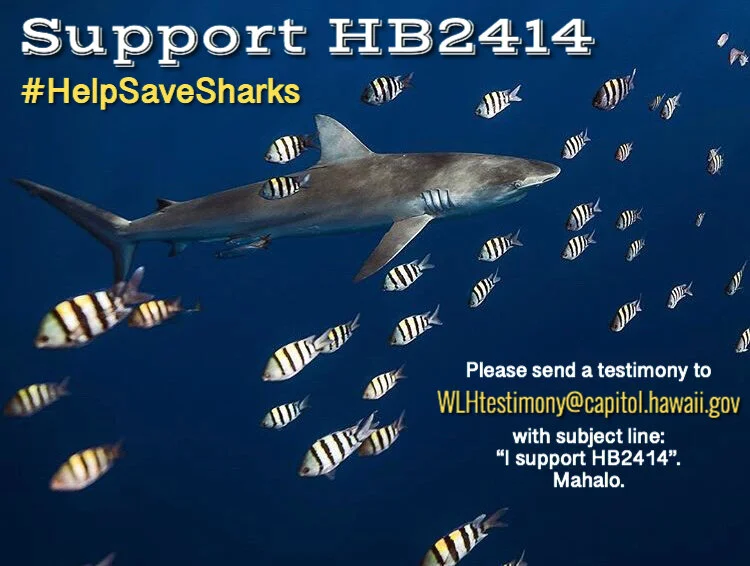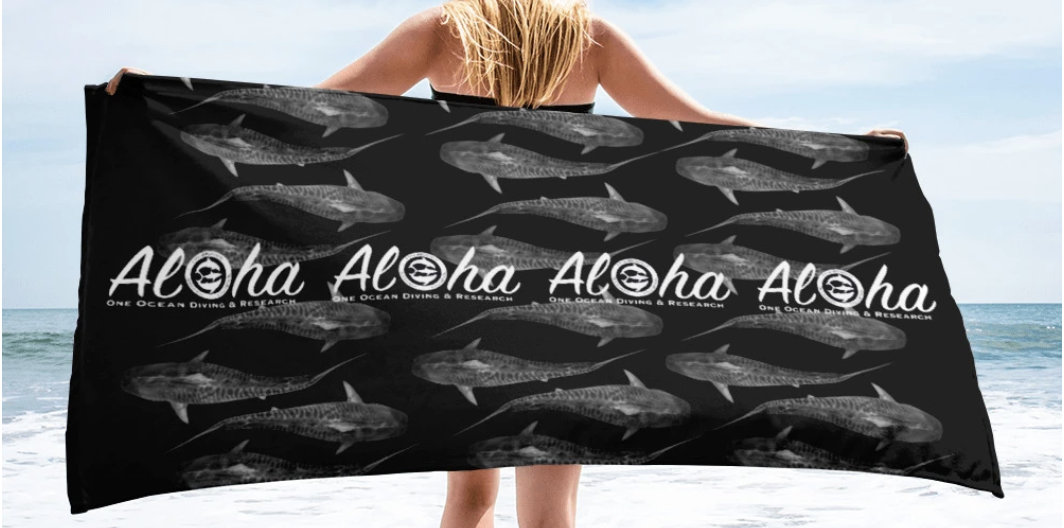Support Legal Protections for Hawaiian Sharks
Please join our efforts to support bill HB 2414 to ban the purposeful killing of sharks and rays in Hawaiian waters. Stay tuned to this page for updates and read the full text of the bill by clicking the button below.
This has passed as of June 8th, 2021 and mahalo for the support.
Please help by emailing “WLHtestimony@capitol.hawaii.gov” with the subject line " Support of HB 2414" and tell them why you believe Hawaii should further protect sharks and rays! DEADLINE: THURSDAY February 6th at 9:30am. (The hearing is not until Friday but testimony must be submitted 24hours in advance. Testimony can still be submitted after that point but is marked late and appears unprofessional). It can be a few words or a few pages, whatever you'd like! Even if you’ve submitted one before, please submit again so the bill can pass this next step! Any submitted testimonies from you will help! We need to get as many written testimonies sent in soon before the hearing on Friday! After submitting your testimony, please encourage your friends and family to do the same. Thank you to anyone who decides to help sharks and rays in Hawaii.
Photo by @juansharks
Email WLHtestimony@capitol.hawaii.gov
Example Testimony for HB 2414 for Reference
Check out this example testimony for reference and feel free use bits and pieces of it as a resource to write in your own words why sharks are important.
I strongly support HB 2414. Sharks are rays are a vital component of healthy marine ecosystems that have experienced rapid declines throughout the last decades. As apex predators sharks are at the top of the food chain, therefore maintaining balance of the the ecosystem by regulating abundance of marine life in lower trophic levels and acting as the immune system of our oceans by picking off the weak, sick and overpopulated keeping fish stocks healthy.
Support for Ecological Importance
Ecosystem models predict that the removal of sharks can result in complex community changes, including trophic cascades, mesopredator release, and consequent declines in some commercial fish and cascading changes in some coastal ecosystems (Ferretti et al. 2010). Additional research indicates that the removal of shark and rays may alter size, structure and population parameters in response to changes in species abundance (Stevens et al. 2000).
In the context of ecosystem level changes specific to Hawaii, a study published in 2000 examined the potential long term impacts of the removal of sharks with the use of a dynamic model ECOSIM that predicts changes in biomasses, yields, and consumption for each group through time. They found that when tiger sharks were removed from the model a total and rapid crash in the abundance of tuna and jacks, and an increase in bottom fishes occurred due to increases in seabird populations which compete with tunas and jacks for food and where no longer subject to top down control by tiger sharks (Stevens et al. 2000). While ecological relationships are very complex and difficult to simulate this study highlights the potential for unforeseen and unintended consequences when sharks are removed.
Further evidence for the ecological importance of sharks can be found when comparing the density, size, and biomass of reef fishes in northwestern Hawaiian islands, a large, remote, and lightly fished area, and the main Hawaiian islands (MHI), an urbanized, heavily fished area. The study by Friedlander & DeMartini in 2002 revealed dramatic differences between the two ecosystems, as grand mean fish standing stock in the NWHI was more than 260% greater than in the MHI, more than 54% of the total fish biomass in the NWHI consisted of apex predators, (primarily sharks and jacks) whereas this trophic level accounted for less than 3% of the fish biomass in the MHI. The study concluded these differences represent both near-extirpation of apex predators and heavy exploitation of lower trophic levels in the MHI compared to the largely unfished NWHI (Friedlander & DeMartini 2002).
A 2008 report by the DLNR-DAR of Hawaii found that Oahu’s reefs have around 1/10th the biomass of apex predators (Willaims et al. 2008) when compared to remote inaccessible reefs, indicating that anthropogenic pressures through the main Hawaiian islands has dramatically reduced populations of sharks and rays that are particularly susceptible to over-exploitation due to life history characteristics including slow growth, late attainment of sexual maturity, long life spans, low fecundity (Stevens et al. 2000).
Support for economic value of sharks
Sharks are also not only ecologically important, but also economically important. Sharks are more alive according to a 2013 study by Cisneros-Montemayor et. al which estimates participants in the shark ecotourism industry expend > USD 314 million per year and is projected to grow based on current trends to an estimated > USD 780 million in tourist expenditures in the next 20 years (Cisneros-Montemayor et al. 2013). Similarly, a 2012 study by Vianna et. al provides support for the argument of non-extractive resource use based on data from shark ecotourism operations in Palau which generates USD$18 million per year, and states that the estimates value of the population of approximately 100 sharks used in the operation to be at most USD$10,800 if they were harvested which is a fraction of worth of these animals as a non-consumptive resource (Vianna et al. 2012).
Based on the scientific studies cited above there is a very clear argument for protecting sharks and rays in Hawaiian waters for their ecological, economic, and intrinsic value. The long term ecological implications of removal of apex predators are difficult to document, but when it comes to conserving such a vital component of our marine ecosystems the precautionary approach should be taken to ensure healthy populations of these animals persist for future generations. Some may oppose this bill because they believe it will be difficult to fund enforcement, but some of the business that stand to gain (shark ecotourism businesses) from this bill could participate in a voluntary “shark watching tax” of $5 for every person who wants to commercially see a shark alive to help with any costs of enforcing this law. We as a community could help to provide the evidence to DLNR to enforce this law leaving no logical reason not to support this bill.
Another Version you can modify
We strongly support SB2717. Globally sharks are facing severe population declines, and the global shark population has declined by 90% of that it used to be in recent decades. Certain species like the oceanic white tip have been depleted by 99% of their former abundance. Sharks are often targeted for the growing list of shark products such as shark fin soup, shark meat sold under various names to mislead consumers, shark liver oil, cartilage supplements, pet food, fertilizer and more. They are also caught inadvertently as by catch by commercial fisheries on a consistent basis.
Here in Hawaii, we are lucky to still have relatively stable populations of sharks, but they still face numerous challenges and threats. It is in the state’s best interests to preserve these animals for future generations. Manō (sharks) are widely respected as sacred ʻaumakua, yet despite their cultural significance sharks have very little functional enforceable protection. The law should reflect the respect the native Hawaiian community has for these animals. There is a need for this bill as sharks are killed for wasteful reasons. While many incidents are not reported or common knowledge, those of us that work within the community are aware of several instances in which sharks were targeted or killed. Scalloped hammerheads (Sphyrna lewini) are a particular concern, as fishermen are known to use juvenile pups as bait for large fish species like ulua (Caranx ignobilis). An individual was cited this year for illegal lay net use in Kaneohe bay, a well known and important nursey ground for the species, after he killed several baby hammerheads but the penalty was only for illegal net use, not because he killed the sharks. Scalloped hammerheads were also recently reclassified globally as critically endangered as of December 2019, but even though they are known to be so vulnerable very little protection is in place. There are several other instances where sharks were killed or left for dead after they were caught, but this is a clear example of why this type of legislation needs to be implemented.
And a 4th Version with all main points you can also modify to your liking:
We strongly support SB2717. Sharks have tremendous value, in the form of both ecological and economic importance. They are more valuable alive both to the states economy and environment. Sharks are top level predators that regulate prey abundance, behavior, and help maintain healthy ecosystems. Locations around the world where sharks have been removed are correlated with degradation of local reefs, reduced ecosystem diversity and function. Sharks also represent significant economic value as as sustainable non-extractive resource in the form of ecotourism. Some programs have even been scientifically proven to positively impact conservation behavior for participants after experiencing and learning about these animals firsthand. Despite population declines of 90-99% for some species in other parts of the world, Hawaii’s isolation and traditional respect for sharks (Manō) as sacred ʻaumakua in Hawaiian culture has resulted in relatively stable populations of sharks remaining in Hawaiian waters. However, studies suggest these populations are depleted in comparison to areas like the Northwest Hawaiian islands where sharks and other large fish species are largely abundant. Sources also suggest these depleted populations are in decline. Purposefully killing sharks or not releasing them when they are caught by mistake is a relatively common occurrence, and this bill would take the first step towards providing basic much needed protections for these vulnerable yet important predators.
Sources
Cisneros-Montemayor, A., Barnes-Mauthe, M., Al-Abdulrazzak, D., Navarro-Holm, E., & Sumaila, U. (2013). Global economic value of shark ecotourism: Implications for conservation. Oryx, 47(3), 381-388. doi:10.1017/S0030605312001718
Ferretti, F., Worm, B., Britten, G. L., Heithaus, M. R. and Lotze, H. K. (2010), Patterns and ecosystem consequences of shark declines in the ocean. Ecology Letters, 13: 1055–1071. doi:10.1111/j.1461-0248.2010.01489.x
Friedlander, Alan & DeMartini, EE. (2002). Contrasts in density, size, and biomass of reef fishes between the northwestern and the main Hawaiian islands: The effects of fishing down apex predators. Marine Ecology-progress Series - MAR ECOL-PROGR SER. 230. 253-264. 10.3354/meps230253.
Stevens,J. D., Bonfi R.l, Dulvy N. K., Walker P. A. ; The effects of fishing on sharks, rays, and chimaeras (chondrichthyans), and the implications for marine ecosystems, ICES Journal of Marine Science, Volume 57, Issue 3, 1 June 2000, Pages 476–494
Vianna, G.M.S., Meekan, M.G. ,Pannell, D.J. , Marsh S.P., Meeuwig, J.J. (2012) Socio-economic value and community benefits from shark-diving tourism in Palau: A sustainable use of reef shark populations,Biological Conservation,Volume 145, Issue 1, 2012,
Pages 267-277.https://doi.org/10.1016/j.biocon.2011.11.022.
WILLIAMS, I., WALSH, W., SCHROEDER, R., FRIEDLANDER, A., RICHARDS, B., & STAMOULIS, K. (2008). Assessing the importance of fishing impacts on Hawaiian coral reef fish assemblages along regional-scale human population gradients. Environmental Conservation, 35(3), 261-272. doi:10.1017/S0376892908004876
https://dlnr.hawaii.gov/dar/files/2014/04/ReefFishStocks.pdf


